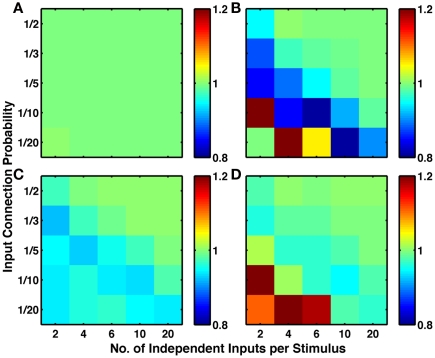Figure A6.
Bidirectional connections are stronger than unidirectional connections in networks with high degrees of clustering. Color indicates ratio of average strength of excitatory connections when the reciprocal connection is present to the strength of those with no reciprocal connection. All simulations include structural plasticity and homeostasis. (A) Simulations with no other functional plasticity show no effect (ratio remains at 1), while (C) simulations with LTPi alone show slightly weaker bidirectional connections caused by homeostasis on the excitatory synapses. By contrast, (B) simulations with triplet-STDP and (D) simulations with LTPi + triplet-STDP show that synapses partaking in a reciprocal connection are stronger than those forming a unidirectional connection in networks with a high degree of clustering (cf. Figures 5 and 6 of the main paper).

